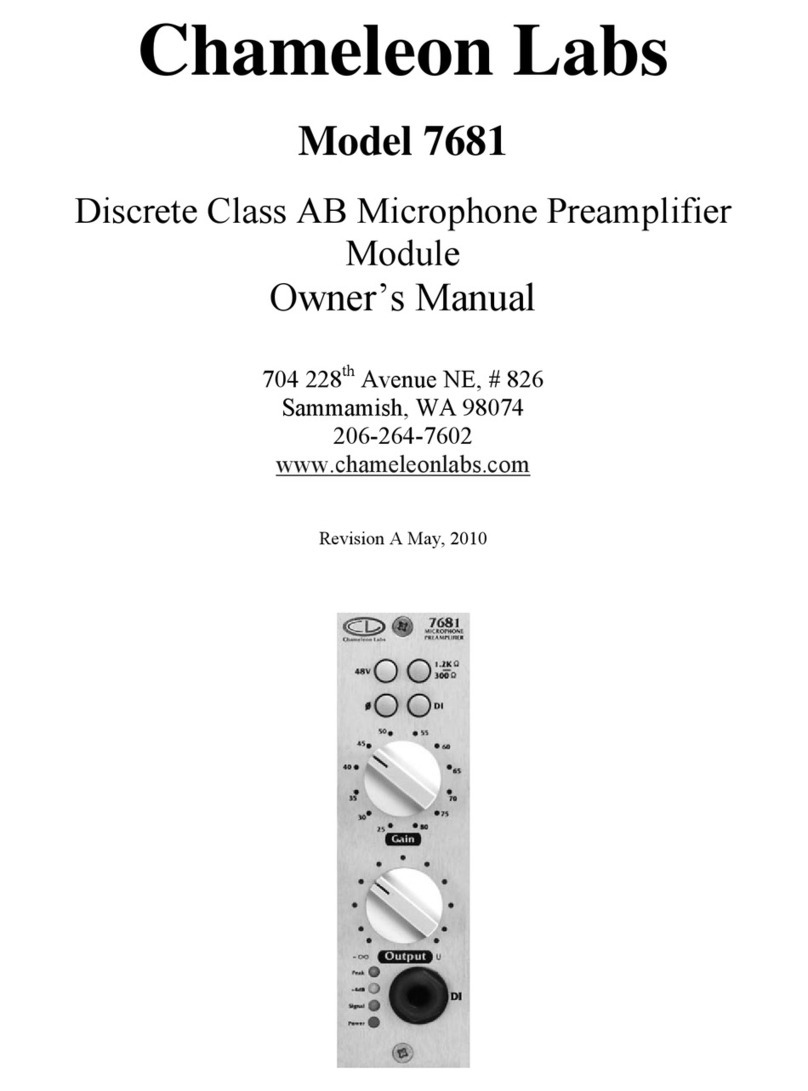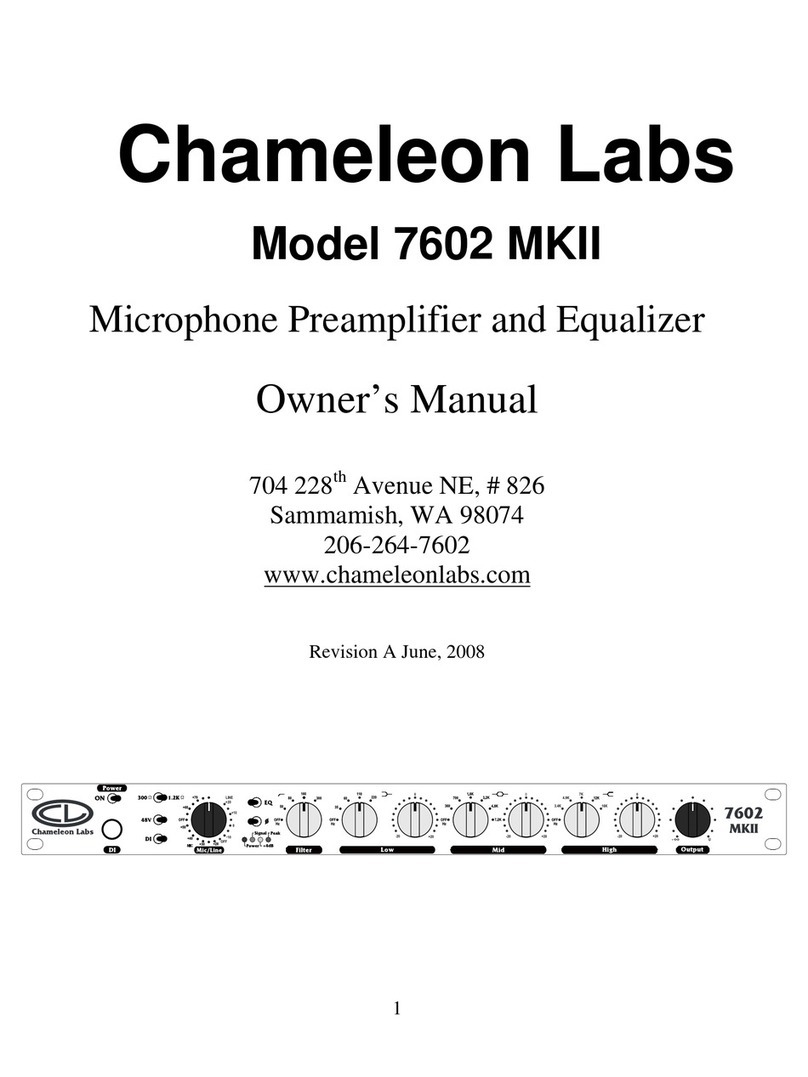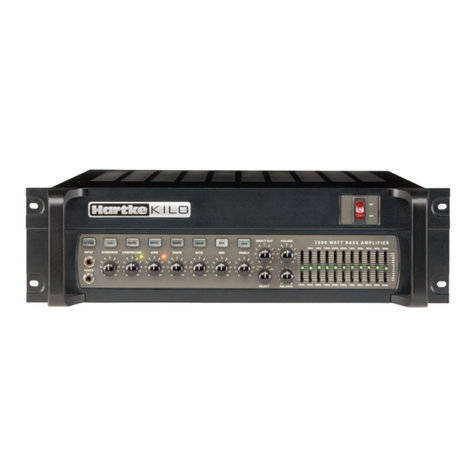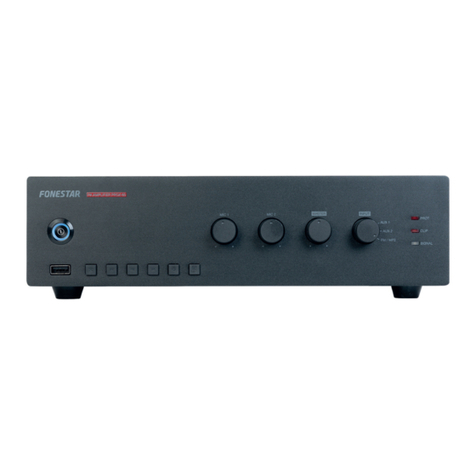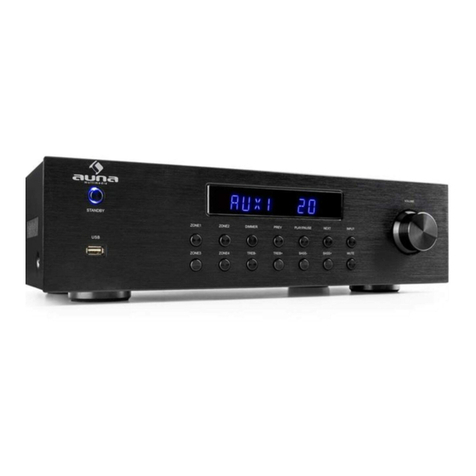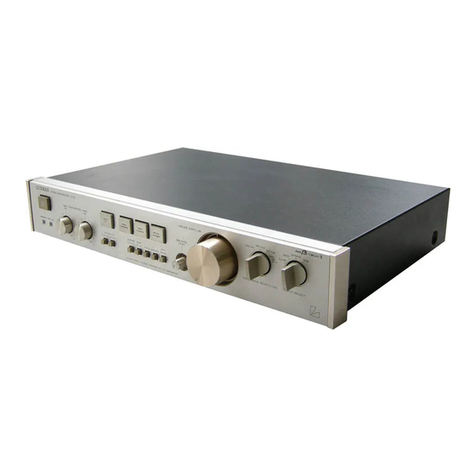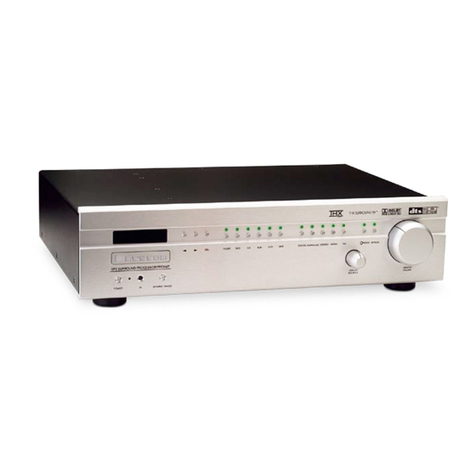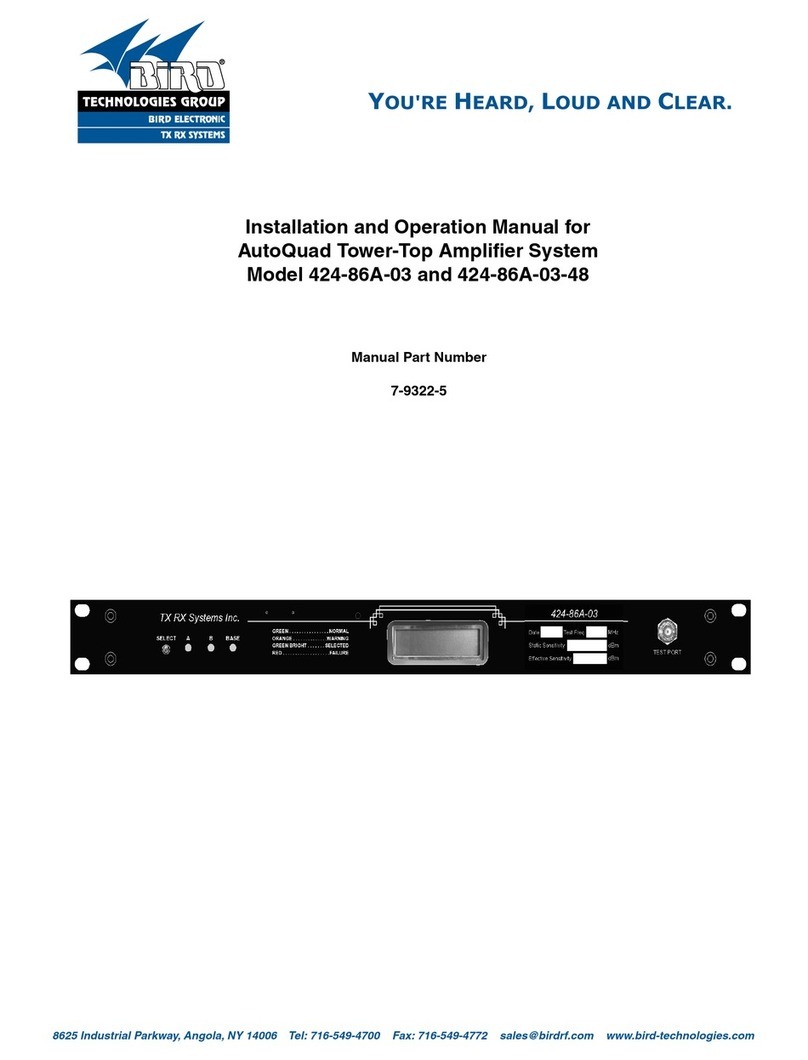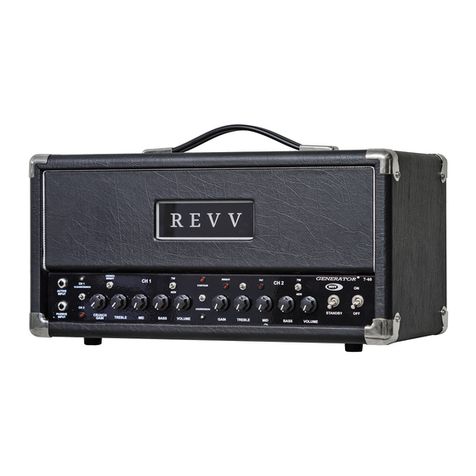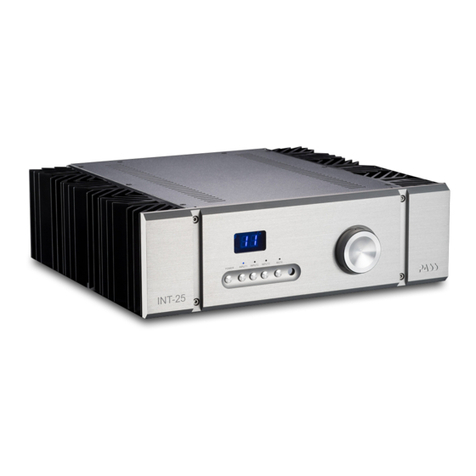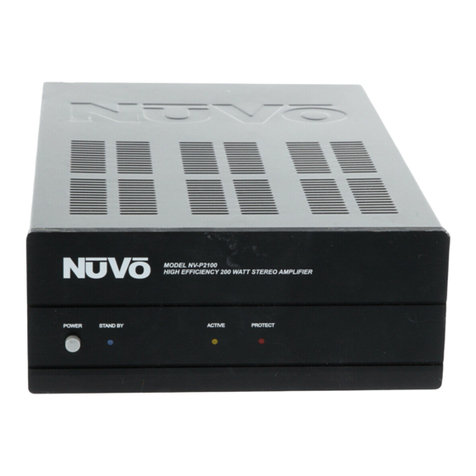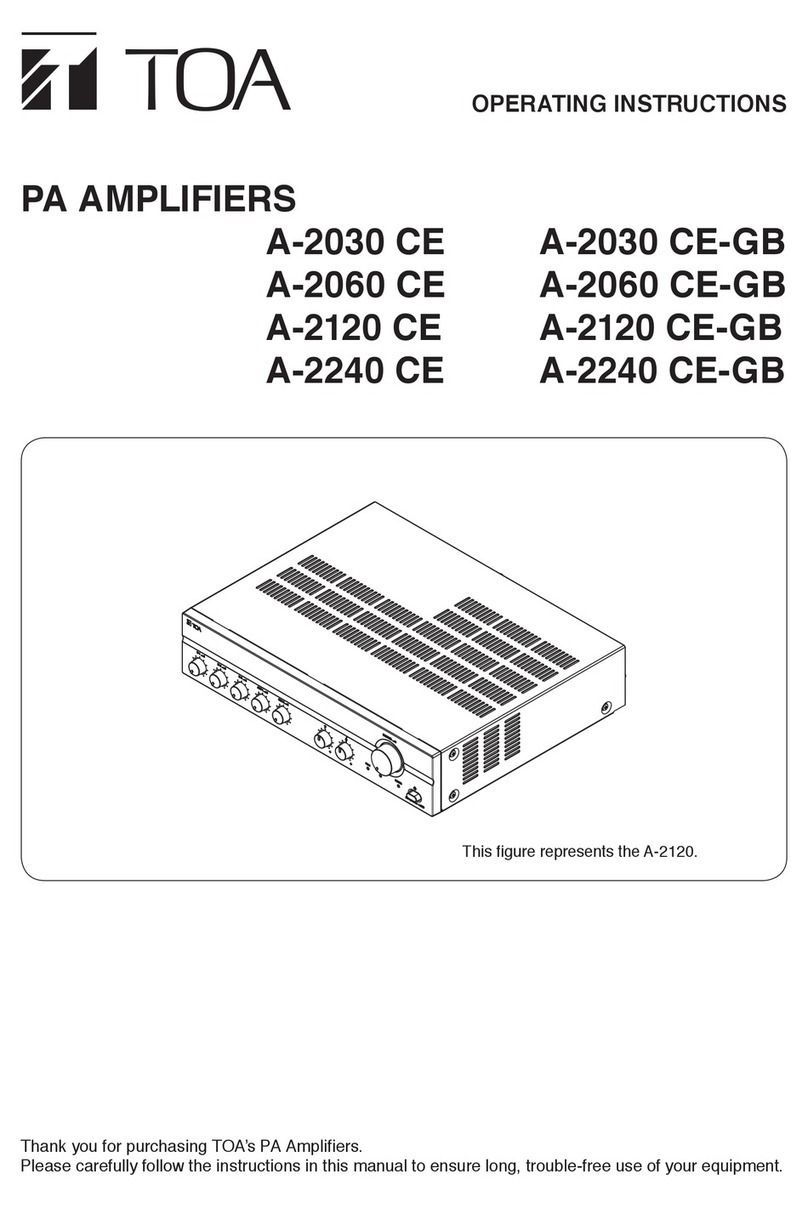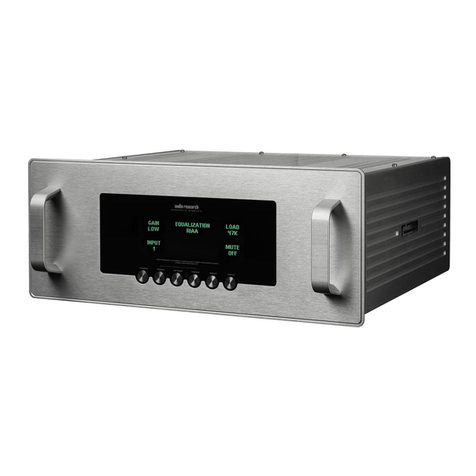Chameleon Labs 7622 User manual

Chameleon Labs
Model 7622
Dual Microphone Preamplifier
Owner’s Manual
704 228th Avenue NE, # 826
Sammamish, WA 98074
206-264-7602
www.chameleonlabs.com
Revision B April, 2007
1

Your Model 7622 microphone dual preamplifier has a
transformer balanced input with a range between 20dB
and 80 dB of gain. The separate line input is transformer
balanced and accepts input levels from -20 to +10dB.
The Model 7622 has been carefully constructed and
individually tested for quality. It utilizes pure class ‘A’
circuitry. This unit is made with 100% discrete
components, hand wound transformers and was fabricated
to precisely match vintage counterparts manufactured in
the early to mid 70’s.
The Chameleon Labs Model 7622 is based on high audio
performance design techniques. By employing classic
circuit design, polystyrene capacitors, a gold contact gain
selector and custom wound transformers Chameleon Labs
ensures that the Model 7622 will exhibit classic audio
sound.
Your Model 7622 represents a dramatic breakthrough in
delivering vintage audio performance at an affordable
price.
2

Features of the Model 7622:
•Fully balanced transformer mic input and output;
•Balanced XLR outputs;
•Hi-Z direct inputs for instruments on the front panel;
•48VDC phantom power selector on the front panel;
•20 position gold contact rotary gain switch for both
Mic and Line sections;
•Output level control functions as a fader when going
straight to tape;
•Oversize power supply provides many times the
current needed for optimum sound quality;
•One-year warranty
3

Front Panel Controls: (Left to Right, per channel)
DI Button-
This button routes the Direct Input jack into the unit.
48V Button-
This button supplies 48 V.D.C. (Phantom Power) to the
Microphone Input XLR jack.
Ø Button-
This button reverses the phase of the unit 180°.
Microphone / Line sensitivity-
This pot controls input level for the microphone and
line inputs. The microphone and line inputs have their
own input connectors on the rear panel and a separate
input transformer. Each rear input has its own section
of the control on the input gain selector switch. The
microphone section provides 20 to 80db of boost in 5db
steps, and the line section provides +10 to -20db of
adjustment.
Output-
Acting as a console fader, this control is placed after the
gain stage and before the output stage. This allows for
trimming of the input signal between the 5db steps of
the input switch, as well as allowing the input to be
4

intentionally overdriven. The normal position for this
control is wide open.
Connecting the Preamplifier
Audio Connection
Microphone input connections are made with the
female XLR connector on the rear of the unit. This
connector is wired with pin 2 HOT, pin 3 common
and pin 1 is ground. (shield) The 48 Volt D.C. power
is supplied on pins 2 and 3.
The Instrument (DI) connection is made using the
balanced ¼” TRS jack on the front panel. The
connector is wired with the TIP being positive, The
RING being negative and the SLEEVE being ground.
(shield)
Line input connections are made with the male XLR
connector on the rear of the unit. This connector is
wired with pin 2 HOT, pin 3 common and pin 1 is
ground. (shield)
Output connection is made using the male XLR
connector on the rear of the unit. This connector is
wired with pin 2 HOT, pin 3 common and pin 1 is
ground. (shield)
5

Power Supply Connection
Two 4 pin, screw on type connectors will provide
power to run the Model 7622 unit. A Model CPS1
power supply is required to power this unit. The
CPS1 power supply contains a toroidal transformer to
reduce 60Hz hum. To insure quiet operation, mount
the power supply at least one rack space away from
the Model 7622 main unit. The Model 7622 comes
with two interconnecting cables that will connect it to
both of the two power outputs on the CPS1. A CPS1
will power one Model 7622 unit. Be careful when
connecting the power cable to insure correct mating
of the two connectors. They are keyed and should go
in with very little effort and then screw down for
added safety. If more than gentle pressure is required,
it is possible that the plug is misaligned and should
be rotated for a correct fit. DO NOT FORCE the
power connector. The power pin is wired as follows:
Pin 4 is Audio Ground (shield)
Pin 3 is +48 Volts D.C.
Pin 2 is +24 Volts D.C.
Pin 1 is -24 Volts D.C.
6

First time users
Set up of the Model 7622
1- Select 40 dB on the Microphone / Line sensitivity
control. Turn the Output control fully counter
clockwise. Make certain that the DI, 48V, and Phase
buttons are all out.
2- Connect a microphone to the Female XLR plug on
the rear panel. If the microphone requires Phantom
Power, press the 48V button in.
3- Connect the male, Line Output XLR connector,
located on the rear panel to the input XLR on your
recorder or D.A.W.
(If you are sending to a device that does not have a gain
control, use the Output control to adjust your signal so
that your loudest signals just fail to reach the maximum
input levels on your recording device.)
4- Turn the Output control clockwise until you can see
level on the input of your recorder. Increase until the
desired level is achieved. ( Vintage Hint: Adjusting the
Microphone / Line sensitivity control along with the
Output control can provide a variety a different sounds
by overdriving the amplifier circuits while lowering the
final output level in order to not overdrive the recorder.
7

5- When an electronic instrument such as an electric
guitar is used, it may be plugged directly into the ¼” DI
plug located on the front panel. Press the DI button in
to select this input device.
6- If phase reversal is needed, press in the phase button
(a zero symbol with a diagonal line through it).
Specifications
Input impedance:
Microphone – 1,200 ohms
Line – 10,000 ohms
D.I. – 100,000 ohms
Sensitivity:
Microphone – -80dBm to -20 dBm in 5dB steps for 0 dBm
output.
Line – -20 dBm to +10 dBm in 5 dB steps for 0 dBm output.
Noise:
Measured at 80 db of gain with 200 ohm input
termination, without 20Hz to 20kHz to assist in
filtering out noise.
-49dbu with final output stage at 50% EIN -129 dbu;
-46dbu with final output stage at unity EIN -126 dbu;
-56dbu without final output stage EIN --136 dbu.
8

Output:
Balanced and floating to feed a 600 ohm load.
Maximum output +26 dBm into 600 ohms, or +20dBm into
150 ohms.
Output impedance:
600 ohms, balanced (source impedance 75 ohms).
Frequency Response:
11 Hz – 77.65 kHz – 3 dB.
Level variation is less than 0.2%.
Distortion:
1k Hz = 0.0245%
All tests results were measured using a Stanford Research
Model SR780 signal analyzer and a Fluke 8060a.
Input signal was 1v rms input signal and 20dbu output
signal.
Warranty and Liability
Your Chameleon Labs product is warranted to the
original owner for a period of one year. Chameleon
Labs guarantees this product to be free from
electrical and mechanical defects and will repair or
replace defective components, or replace the
9

microphone at Chameleon Lab’s option. Should
service be required for your Chameleon Labs
product, please contact the manufacturer. Service is
provided for products beyond the warranty period.
Seller warrants that the goods are described in this
agreement, but no other express warranty is made in
respect to the goods. The entire risk as to the quality
and performance of the good is with the buyer. Seller
disclaims all warranties either expressed or implied,
including any implied warranty of merchantability or
fitness for a particular purpose, and seller neither
assumes nor authorizes any other person to assume
for it any liability in connection with the sale of said
goods.
MODEL NUMBER ___________________________
SERIAL NUMBER ____________________________
DATE OF PURCHASE __________________________
PURCHASED FROM ___________________________
10
Table of contents
Other Chameleon Labs Amplifier manuals
